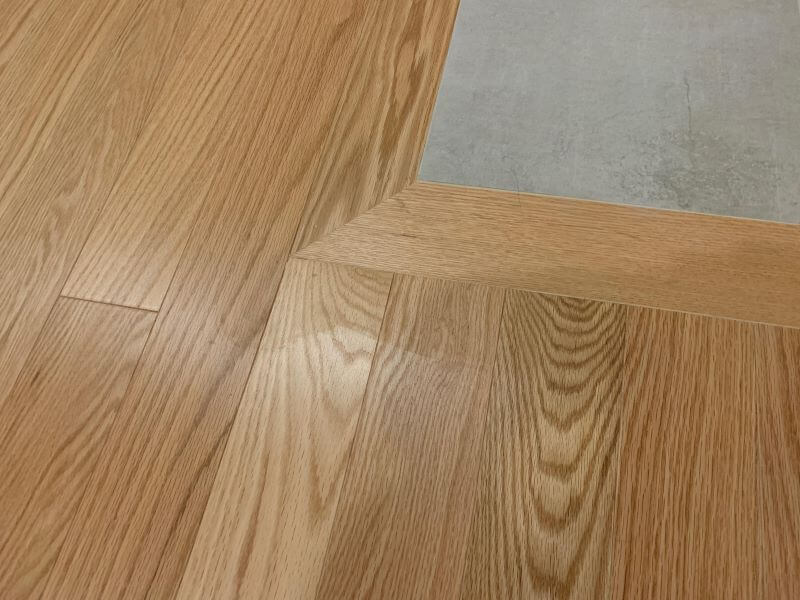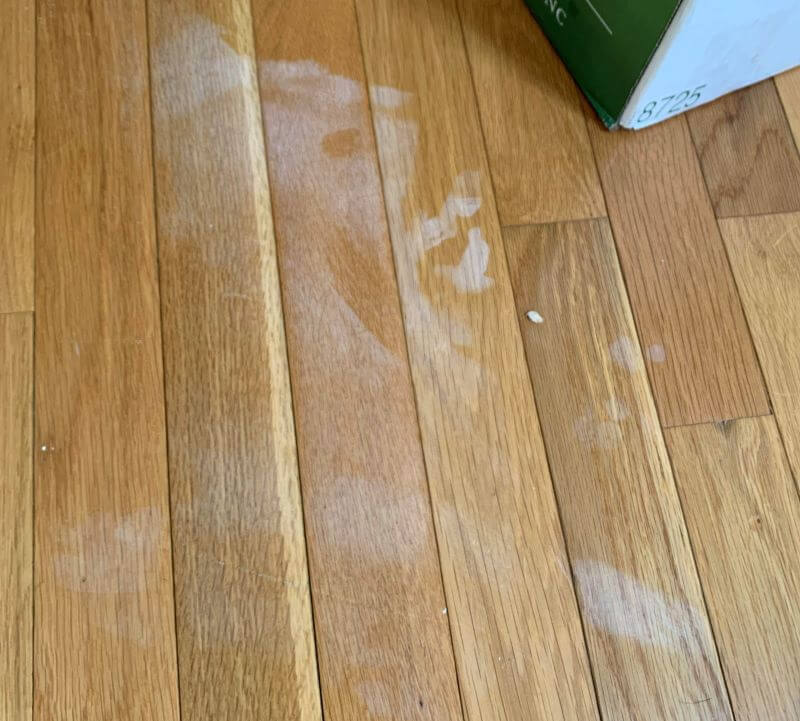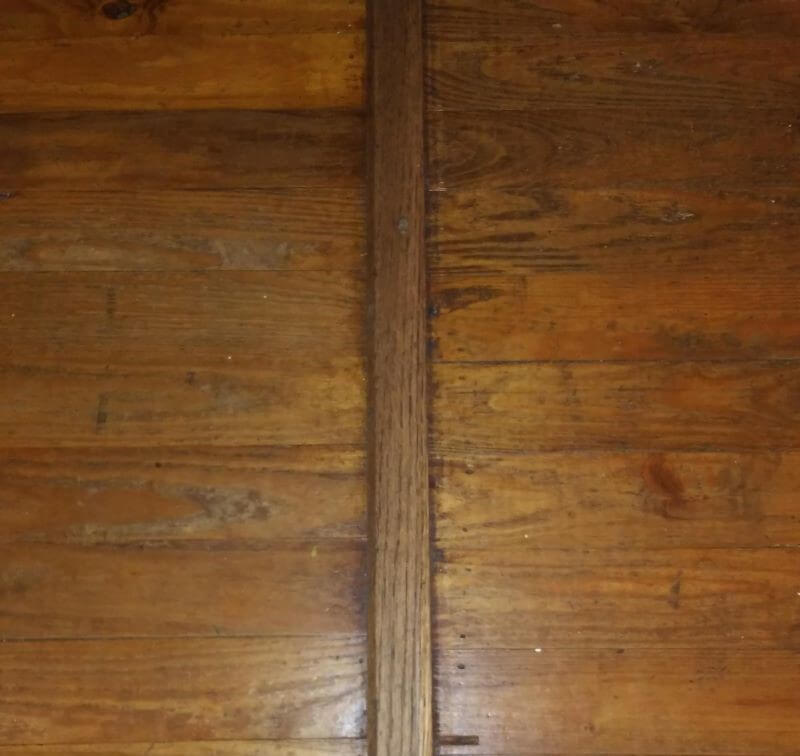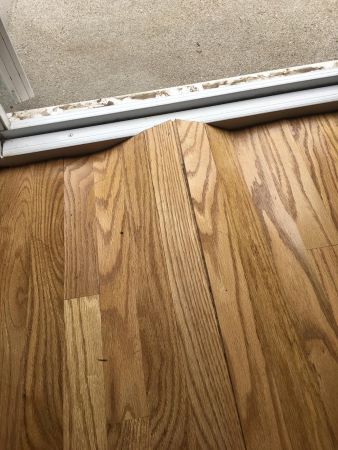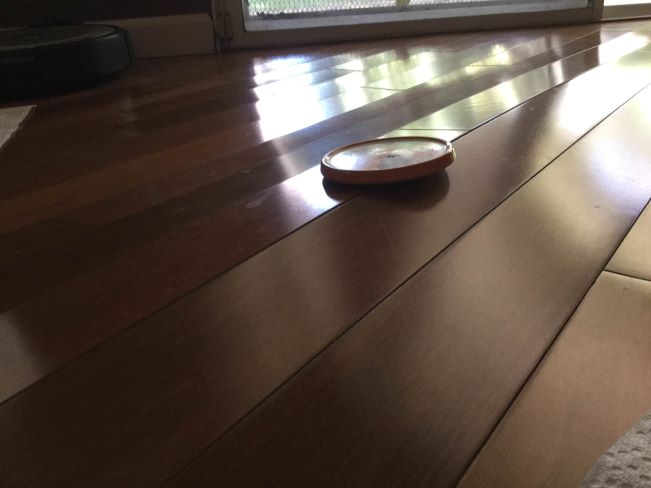For many people who have hardwood floors in their homes, the appearance of white spots and white marks can be both perplexing and frustrating. What caused them? Where did they come from? How do I get remove white spots on wood floors?
In this article, we’ll answer all these questions and offer some tips for prevention as well.
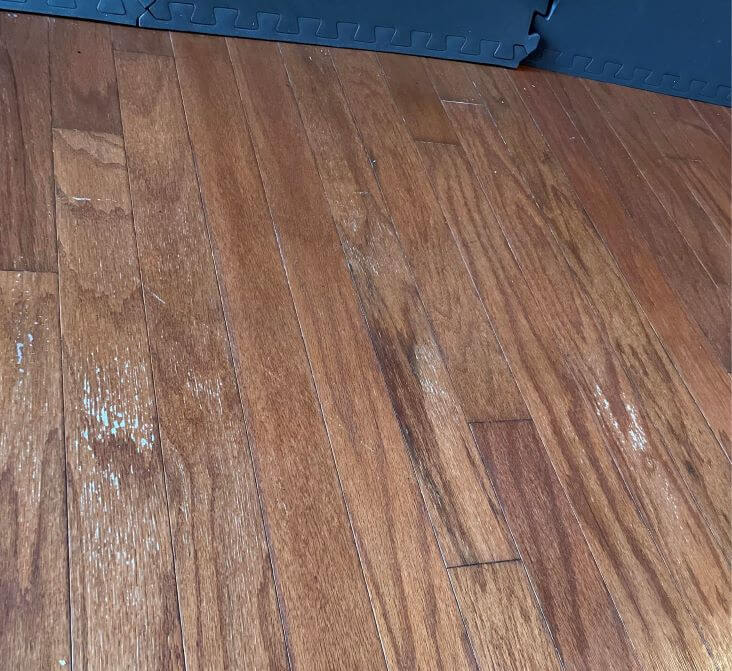
What Causes White Spots on Wood Floors?
Although there are a lot of ways to prompt them, there aren’t too many causes of white spots and white marks on hardwood floors. Let’s discuss these:
Heat
If you enjoy watching TV while sitting cross-legged on the floor eating a pizza, you should probably consider how hot the underside of a pizza carton can be.
The same goes for most cardboard or foil boxes that are used to contain hot food for delivery. These containers are all designed to keep food hot.
Heat can also be transferred through the bottom of a full coffee or soup mug, or a bowl of hot pasta.
Moisture
Trapped Moisture
If your floors have been recently refinished, white, cloudy spots may form in areas where there wasn’t enough drying time between the coats of lacquer.
Where a wood floor’s finish is worn, water can seep under the edges of the finish and also become trapped between the layers
Spills and Condensation
If you’re washing that pizza down with an ice-cold beverage, resting the can or bottle on the wood floor can cause white marks. This is the result of condensation traveling down the outside of the can or bottle. Left unchecked, water spills on hardwood floors and condensation can form white water marks on a wood floor.
Tap Water
In terms of water, “hard” is the term used to describe water with high mineral content.
On some level, most tap water contains minerals. When water evaporates, the minerals remain. Damp mopping with tap water can cause white spots to appear if droplets are allowed to evaporate before they’re dried. The harder the water; the bigger the problem.
Rainwater
Rainwater that’s tracked in from outside is a more common concern in climates with heavy or long rainy seasons.
In these cases, white spots are usually more present nearest a home’s entry doors. This is because rainwater usually contains sodium. On hardwood floors, when rainwater evaporates, the sodium remains.
Snow
As if water tracked in from outside isn’t bad enough news, snow along with its naturally high sodium content can be especially rough on hardwood floors. Rainwater is naturally salty, but snow is even saltier.
In the northern hemisphere, wood floors surrounding entry doors can quickly become almost entirely white during the winter. The melted snow’s deposits of salt and other minerals often combine to form what appears to be a large cloud.
Removing scale from a hardwood floor can be a tedious and time-consuming challenge.
Mold
If the white spots were discovered under a potted plant or under something that remained in direct contact with the floor (boxes, cushions, or even shoes), this could be white mold.
Mold needs two things to survive; moisture and a food source. In this case, the food source is wood.
This type of trouble is more prevalent in moist climates. White mold usually grows in dark, dank areas of a home. You might notice a white powdery substance on the edges of the wooden basement stairs or the basement ceiling joists that support the floor above.
If a roof has leaks or isn’t properly ventilated, white mold might be present on the attic rafters or crawlspaces.
In some cases, the overall appearance of mold can become darker as it generates more spores.
For some people, this situation can send health spiraling downward. For others, the same situation might not even prompt a sneeze.
Read our article on how to remove mold on wooden floors to deal with this.
Spider Poop
Yes. You read that right.
No. We’re not kidding.
Granted, spiders don’t usually gather out in the open for a poop pow-wow or defecation shindig on hardwood floors.
In fact, most spiders don’t even do this on special occasions. (!) But if it’s been a while since the last time the corners of the room were dusted, well …anything’s possible.
Cleaning Solutions For Removing White Spots That Can Ruin Hardwood Floors
When some people think about removing hard water deposits, the first solution that comes to mind is a container of all-in-one calcium, lime, and rust remover. This type of product can be very destructive to wood and wood finishes.
For other people, the solution is vinegar. But vinegar’s low Ph content makes it as unsuitable for cleaning wood floors as other acidic solutions. Vinegar is corrosive. Corrosives should not be used as wood floor cleaning solutions.
Of course, vinegar can be diluted, but if you’re going to do that, you might as well dilute lemon juice. The Ph content is about the same and lemons smell good.
How To Remove White Spots From Hardwood Floors?
The solution to white spots and marks depends on the cause:
White Spots Caused By Heat
The remedy for this is quick and simple; Place a dampened terry cloth towel on the spot and hold a blow dryer over it.
Start with the blow dryer on the lowest heat setting and check your progress every few seconds.
White Spots Caused By Trapped Moisture
More often than not, these will go away on their own.
If not, treat these as you would a white spot caused by heat, but leave the dampened terry cloth towel out of the process.
Removing Spots Of White Mold
If the white spots are limited to an isolated area such as under a potted plant, a pair of shoes, etc., hydrogen peroxide will remove this. Hydrogen peroxide also functions as a mildewcide.
(See, How To Remove White Spots Caused By Moisture…)
However, if you discover white mold in other places as well, the best thing to do is to call a mold remediation specialist. A remediation service ensures the removal of all mold throughout the entire home.
To Remove Spider Dung
Dust the corners and spray some pet stain cleaner on the um… er… spots. They will disappear in a few minutes. Wipe the area dry with a microfiber cloth (If you’d rather use several squares of t.p., that’s your prerogative).
To Remove White Spots Caused By Moisture
Alkali and acid neutralize one another.
Because most forms of water are somewhat alkaline, a somewhat acidic solution should be used to remove the minerals that remain after evaporation. Hydrogen peroxide in an appropriate concentration will serve this purpose.
Things You’ll Need:
- Floor Vacuum (or a vacuum with a setting for wood floors or with a hard floor accessory attachment. Nothing with a brush roller)
- Face Mask
- Rubber, Latex, or Vinyl Gloves
- 8 oz. Hydrogen Peroxide 6% (or 1 oz. pure lemon juice and 10 oz. distilled water)
- Spray Bottle (Empty and clean)
- Neutral Ph Floor Cleaner for Hardwood
- Flip-Head Mop
- Several Two-Sided Mop Pads (one side for damp mopping, the other side for drying)
- Several Terry Cloth Towels
- Plastic Putty Knife
- Whisk broom and dustpan
Instructions:
- Put on the face mask and gloves
- Transfer the hydrogen peroxide or lemon water solution into the spray bottle
- Spray a small area (1’ x 1’) of the floor
- While this area of the floor is still wet, use the plastic putty knife to gently remove as much of the offending white crud as possible. Don’t worry if you can’t get all of it. We’ll discuss what to do about the rest later. Pro Tip: When scraping any surface with a putty knife, it’s important to always keep the surface wet.
- Scrape residue from the putty knife into the dustpan.
- Wipe the area with a water-dampened terry cloth towel as you move from one area to the next. After you’ve scraped up as much of the white stains as can be easily scraped from your wood floor, you’ll move on to confront the more stubborn deposits that remain.
- Saturate several terry cloth towels with distilled water and wring them out until they’re damp only
- Focusing on a 3’ x 3’ section of the floor, spray the remaining patches of white with the solution in the spray bottle (It’s easier to work in sections not larger than about 3’ x 3’)
- Place the damp terry cloth towels over the white stains.
- Check the stains every five minutes to see if they come up more easily. If they don’t, leave the dampened towels in place until the next check. Be sure to keep the towels damp. Exchange them with freshly dampened towels if necessary.
- When the stains have become less resistant, remove them with your putty knife as you did earlier with the less stubborn ones
- Move to the next section of the floor and repeat steps 8-11
- When all the white spots and marks have been removed, damp mop the entire floor with the neutral Ph floor cleaner. Use the chenille side of the mop pad to dry and buff the floor as you go
- Follow up with the Neutral pH Cleaning Solution according to the manufacturer’s directions for use
Preventing White Spots on Hardwood Floors
As always, the key to the life and beauty of hardwood floors is proper care.
Of course, it might be possible to go on forever about various difficulties that can come with hardwood floors. But in reality, these challenges are usually the result of improper or lacking maintenance. Where a simple but solid care and maintenance routine is in place, these challenges rarely present themselves.
Listed in random order, here are some measures to take to prevent white spots:
- Clean up spills as soon as they happen
- If you’re inclined to using your hardwood floor as a coffee or dining table, be sure to use coasters.
- While you’re at it, set that pizza carton on a pair of oven mitts
- To clean your hardwood floor, try using a neutral Ph floor cleaner intended for use on hardwood
- When damp mopping, be sure to dry the floor as you go
- If your tap water is hard, use distilled water to damp mop
- Remove potted plants from the floor
- Place protective floor mats on either side of exterior doors. To ensure that shoes are dry, place two or three mats next to one another inside the entry
- Keep a towel handy so that Fido’s paws can be dried when he comes in after getting them wet
- Better yet, buy Fido some protective footwear
- Even better still, be sure that everyone removes wet footwear upon entering the home (You too, Fido)
- Have and use an appropriately located umbrella stand
- If your home doesn’t have a mudroom or some form of an anteroom, try setting up an entry bench with shoe storage. That way, items 9 and 11 can be more easily managed
- Mount coat hooks and a hat rack over the bench so that outerwear can be removed when entering the house
- Get in the habit of entering through the door located nearest to wherever the floor cleaning equipment and supplies are stored
- Be sure to include corners in your usual dusting routine to ensure the removal of spider webs
- Place rugs in areas of your wood floor where foot traffic is heavy. This will prevent the finish from becoming worn.
Whatever type of hard floors are installed in your home, in addition to preventing white spots, keeping floors dry will go a long way to reducing the risk of slips and falls.


